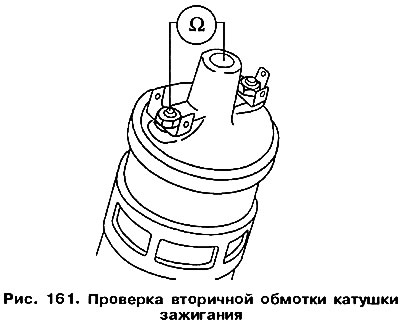All ignition systems
The ignition coil is checked with an ohmmeter. Disconnect all wires from the ignition coil.
Connect an ohmmeter to terminal 1 (-) and to terminal 15 (+) ignition coils (pic. 160).

Measure resistance. The specified values should be 0.52-0.76 ohms.
Connect an ohmmeter to terminal 1 (-) and to terminal 4 of the ignition coil (pic. 161).

Measure resistance. The set values should be 2.4-3.5 kΩ.
At deviations from the set values replace the ignition coil.
Attention! The short circuit in the ignition coil cannot be established by measuring the resistance; that is, if there is no high voltage, although there are no defects in the switching unit of the transistor ignition system or in the Hall sensor, the ignition coil should be replaced.
In the absence of an ohmmeter, the ignition coil is checked as follows:
Attention! Check in the given sequence. Do not hold the ignition wires with your hands while the starter is running. To do this, use an insulated tool or secure the wire with adhesive tape in a predetermined location on the engine.
- Disconnect the high voltage wire from the middle of the distributor cap and keep it at a distance of about 10 mm from «masses». When turning the engine with the starter, a spark should jump.
- If the spark does not jump, first measure the voltage at terminal 15 with a voltmeter with the ignition on (+) ignition coils. The voltage must be at least 9 V.
- Disconnect both low voltage wires from the ignition coil. Connect a 12 V / 21 W incandescent lamp to both wires and crank the engine with a starter. If the lamp lights up during starting, replace the ignition coil.

Visitor comments